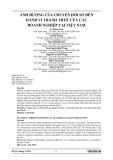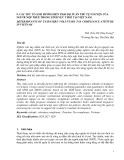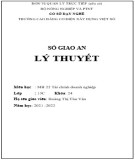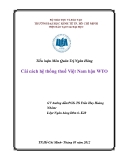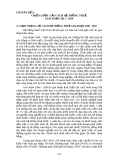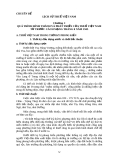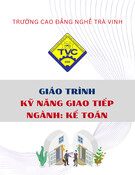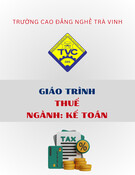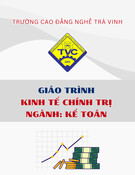
http://www.iaeme.com/IJM/index.asp 111 editor@iaeme.com
International Journal of Management (IJM)
Volume 7, Issue 6, September–October 2016, pp.111–115, Article ID: IJM_07_06_012
Available online at
http://www.iaeme.com/ijm/issues.asp?JType=IJM&VType=7&IType=6
Journal Impact Factor (2016): 8.1920 (Calculated by GISI) www.jifactor.com
ISSN Print: 0976-6502 and ISSN Online: 0976-6510
© IAEME Publication
DEMYSTIFYING GST (INDIA)
Akanksha Jain
Department of Commerce, PGDAV College, University of Delhi, India.
ABSTRACT
The Goods and Services Tax, which is also known as VAT in many countries is a multi-stage
consumption tax on goods and services. It is levied on the supply of goods and services at each stage
of the supply chain from the producer up to the stage of final consumption. The taxation of goods
and services in India has, hitherto, been characterized as inconsistent and distortionary tax, resulting
in mis-allocation of resources, lower productivity and economic growth. Thus, the need for a uniform
formula for the calculation and implementation of tax has been felt for a very long time. The new
amendment on GST aims at removing all these distortions and moving India towards greater growth.
The Constitution Amendment Bill for Goods and Services Tax (GST) was approved by The President
of India post its passage in the Parliament (Rajya Sabha on 3 August 2016 and Lok Sabha on 8
August 2016) and after ratification by more than 50 percent of state legislatures. The Government of
India is committed to replacing all the indirect taxes levied on goods and services by the Centre and
States, and implementing GST by April 2017. The following paper examines salient features of the
new GST Act in India.
Key words: Constitution, GST, Tax, India, Salient features.
Cite this Article: KDV Prasad and Rajesh Vaidya, Factors Influencing the Performance Appraisal
System among Women and Men: A Comparative Analysis using Multinomial Logistic Regression
Approach. International Journal of Management, 7(6), 2016, pp. 111–115.
http://www.iaeme.com/IJM/issues.asp?JType=IJM&VType=7&IType=6
1. INTRODUCTION
Indian tax system is considered one of the most complex systems in the world on account of existence of
multiple taxes. Taxes such as, purchase tax, central sales tax (CST), value added tax (VAT) and many others
make it difficult to undertake any business activity in India. Moreover, the dissimilar taxation rates at the
state level create a mammoth amount of misperceptions and mistrust. The tax base is fragmented between
the Centre and the States. Services, which make up half of the GDP, are not taxed appropriately. In many
situations, the existing tax structure has cascading effects. These problems lead to low tax-GDP ratio, besides
causing various distortions in the economy. A uniform tax structure that does not vary from state to state,
from product to product has been the need of hour. Introduction of GST is seen as the much needed tax
reform to address many of the problems associated with the current tax system. This paper is aimed at
throwing light on the fundamental principles and dimensions of GST in India.

Akanksha Jain
http://www.iaeme.com/IJM/index.asp 112 editor@iaeme.com
2. GOODS AND SERVICES TAX
The Goods and Services Tax or GST, officially known as The Constitution (One hundred and twenty second)
Amendment, is a uniform, comprehensive, destination-based indirect tax applicable on manufacturing, sale
and consumption of goods in India. It is the boldest and the biggest tax reform in more than 60 years of
Indian history. GST, being a destination-based consumption tax, based on value-added principle, would also
greatly help in removing economic distortions and will help in development of a common national market.
3. GST TIMELINE
• The discussion on GST was started by the Atal Bihari Vajpayee government in 2000. He set up an empowered
committee, which was given the task of designing the GST model, developing the IT required and overseeing
its successful roll out.
• In 2003, The Kelkar Task Force on implementation of the Fiscal Responsibility and Budget Management
legislation (FRBM Act), reinforced the need for a uniform Goods and Service Tax (GST). It pointed out the
many impediments in the existing system of taxation of goods and services.
• In 2006, Shri P. Chidambaram, the than Finance Minister, mooted out a proposal to introduce a national level,
Goods and Services Tax (GST). Since the proposal involved reform/ restructuring of not only indirect taxes
levied by the Centre but also the States, the responsibility of preparing a design and road map for the
implementation of GST was assigned to a Empowered committee headed by Dr. Asim K. Dasgupta,
• In 2008, the Empowered Committee submitted a report to the Central Government titled “A Model and
Roadmap for Goods and Services Tax (GST) in India” containing broad recommendations about the structure
and design of GST.
• In 2014, Finance Minister Arun Jaitley presented GST as the Constitution (122nd Amendment) Bill, 2014 in
the Lower House (Lok Sabha).
• On 6th May 2015, the GST bill was passed by the Lower House.
• On 3rd August 2016, after a series of deliberations and amendments, the bill was passed by the Upper House
(Rajya Sabha) of India
• The amended bill was then re-approved by the Lower House on 8th August 2016.
• On 12th August 2016, Assam became the first state to ratify the bill, followed by other states like Maharashtra,
Haryana, Bihar, Jharkhand, Himachal Pradesh, Chhattisgarh, Gujarat, Telangana, Madhya Pradesh, Delhi,
Mizoram, Nagaland, Sikkim and Goa.
• The bill, after ratification by the States, received assent from President Sh. Pranab Mukherjee on 8th
September 2016.The GST Bill now, became The GST Act.
• The GST Act is proposed to be rolled out by April 1, 2017.
4. UNDERSTANDING GST
GST is defined as a consumption based tax levied on sale, manufacture and consumption of goods and
services at a national level. This tax will be substituted for all indirect taxes levied by State and Central
government. Exports and direct taxes like Corporate tax, Income tax will not be affected by GST. GST is a
destination based tax, implying that all SGST collected, will accrue to the state where the consumer of the
goods and services sold resides.
India has adopted a “Dual GST” system, which shall be concurrently levied by Central and State
government. This will comprise of:
• Central GST (CGST) - levied by Central government
• State GST (SGST) - levied by State Government
• Integrated GST (IGST) - levied by Central government on interstate supply of goods and services.

Demystifying GST (India)
http://www.iaeme.com/IJM/index.asp 113 editor@iaeme.com
4.1. Salient Features
4.1.1. GST Council
Administration of GST will be the responsibility of the GST Council, which will be the apex policy making
body for GST. This council will function under the chairmanship of the Union Finance Minister and will
have ministers nominated by the States and Union territories, with legislatures, as members. The GST
council shall make recommendations to the Unions and States on issues like rate of tax, exemption list,
maximum and minimum tax limit etc. Decision making will be based on majority of not less than three-
fourth of the weighted votes, with the Union finance minister representing one-third of the votes cast and all
states together representing the remaining two-thirds.
4.1.2. Taxes Subsumed Under GST at the Centre Level
• Central Excise duty,
• Additional Excise duty,
• Service tax,
• Additional Custom duty (CVD)
• Special Additional duty of Customs
• Excise duty levied under the Medicinal preparation (Excise Duty) act 1955
• Central Surcharge and Cess
4.1.3. Taxes Subsumed Under State GST
• Sales tax/VAT
• Entertainment tax (other than the tax levied by local bodies)
• Central Sales Tax
• Octroi and Entry Tax
• Purchase Tax
• Luxury Tax
• Taxes on Lottery
• Betting and Gambling
• State Cesses and Surcharges
4.1.4. Differential Treatment for Alcohol, Tobacco and Petroleum Products
• Alcoholic liquor for human consumption has been excluded from the purview of GST. The manufacture and
sale of the product will continue to be taxed by states.
• Tobacco and tobacco products will be subject to central excise duty in addition to GST. While not excluded
from GST, it is retained in entry 84 of List I (union list) also.
• Petroleum and petroleum products, i.e., crude, high speed diesel, motor spirit, aviation turbine fuel and natural
gas, has been constitutionally included under GST. However these products shall not be subject to levy of
GST, and will continue to be taxed in the present mode – central excise duty on manufacture and VAT / CST
on sale till notified by the GST Council.
4.1.5. GST - State Compensation
In this transition phase, a number of states shall suffer losses due to the shift from origin based to destination,
based indirect tax structure. The center has thus committed to compensate all such losses for a period of five
years. The compensation for the first 3 years would be 100% of the shortfall. Then 75% and 50% in the fifth
year. The GST Council shall recommend the amount of compensation based on loss of revenue.

Akanksha Jain
http://www.iaeme.com/IJM/index.asp 114 editor@iaeme.com
4.1.6. Revenue Neutral Taxation Rates
A revenue neutral rate structure shall be implemented based on four rates:
• Merit rate / concessional rate for necessary goods - goods of basic importance
• Standard rate for all goods and services in general
• Nil rate for exempted goods or services
• Special rates - for precious metals (gold and jewelry)
4.1.7. Inter-state Transactions
• The power to make laws in respect of supplies in the course of inter-state trade or commerce will be vested
only in the Union Government.
• The Centre will levy IGST on inter-state supply of goods and services. These are destination based taxes,
accordingly, tax shall get transferred to importing state.
• Import of goods will be subject to basic customs duty and IGST.
• Exports and Supplies to SEZ units will be zero rated.
4.1.8. Goods and Services Tax Network (GSTN)
Goods and Services Tax Network (GSTN) is a Section 25 (not for profit), non-Government, private limited
company. The Government of India holds 24.5% equity in GSTN and all States of the Indian Union,
including NCT of Delhi and Puducherry, and the Empowered Committee of State Finance Ministers (EC),
together hold another 24.5%. Balance 51% equity is with non-Government financial institutions. The
Company has been set up primarily to provide IT infrastructure and services to the Central and State
Governments, tax payers and other stakeholders for implementation of the Goods and Services Tax (GST).
4.1.9. GST Suvidha Providers (GSP)
GSP are the third party service providers. Taxpayers shall interface with GST System via GST system portal
or via GSP ecosystem provided by way of applications for activities such as Registration, Tax payments,
Returns filing and other information exchange with GST core system. Information captured on the GST
System will be shared with the respective State/Union Territories (UTs) and Centre (CBEC) for further
processing. State/UTs and Centre will process the information in their respective tax administrative systems
and re-transmit the processed information to GST system which will be available for Taxpayers for viewing
various MIS reports via their choice of applications.
5. CONCLUSION
India will be one of the very few countries with a dual GST regime alongside Canada and Brazil. The all-
important rate is yet to be finalised. The GST rate will be decided in the coming months by a GST Council
that will prise the Finance Minister with a representative from each state government. As such it will be
negotiated amongst the Union and state governments that will jointly administer the GST regime. It will still
remain complex and difficult to implement, but would surely make life easier for businesses by cutting down,
or rather combining, the many indirect taxes that companies file in India. Foreign media has called GST one
of the world’s most complex tax reforms that needs to be supported and serviced by state-of-the-art
technology.
The new GST tax regime, is expected to bring down tax rates in India, while converting the country into
a big single market. Implying that continuous flow of goods and services will occur across 29 states and 7
union territories. The passage of GST bill is presumed to be the biggest tax reform which shall catapult India
into the big league in global supply chain. The implementation of the Bill is expected to ease India’s
cumbersome tax system, help goods move seamlessly across state borders, curb tax evasion, improve
compliance, increase revenues, spur growth, boost exports, and attract investments by improving ease of
doing business in India.

Demystifying GST (India)
http://www.iaeme.com/IJM/index.asp 115 editor@iaeme.com
Though a number of processes and steps are underway for the successful implementation of GST but it
still remains to be seen…how difficult will the implementation process be given the dual nature? What would
be an ideal timeframe by which benefits will be realised? And is it the so called biggest tax reform which
shall pull, push and eventually place India into the Big League in the global market.
REFERENCE
[1] H. Jayaram, India GST for Beginners, (India: White Falcon Publishing, 2016)
[2] CA A. Raj Kumar, E-Book on GST (Goods and Services Tax)
[3] V. S. Datey, A Complete Guide to Model GST Law, (India: Taxmann Publication, 2015)
[4] B. Viswanathan, Goods and Services Tax (GST) in India, (India: New Century Publications, 2016)
[5] http://www.thehindubusinessline.com/todayspaper/tp-others/tp-taxation/article2286103.ece
[6] http://finmin.nic.in/workingpaper/gst%20reforms%20and%20intergovernmental%20considerati
ons%20in%20india.pdf
[7] http://economictimes.indiatimes.com/topic/GST
[8] http://www.moneycontrol.com/newstopic/gst/
[9] http://www.businessstandard.com/article/economy-policy/gstreform-may-be-implemented-after-
elections-ubs- 114011200205_1.html
[10] Dr. N.S. Rathi and Emhemad Omar .A. Abusef, “Innovations in International Accounting and Taxation
System in Global Arena; Challenges Ahead”. International Journal of Management (IJM), 5(2), 2014, pp.
69–74.
[11] http://www.ficci.com/spdocument/20238/Towar ds-the-GST-Approach-Paper-Apri-2013.pdf
[12] http://www.gstindia.com/gst-to-be-game-changer-for-manufacturing-ease-of-doing-business-ramesh-
abhishek/
[13] http://www.gstindia.com/about/
[14] http://www.ey.com/in/en/services/ey-goods-and-services-tax-gst
[15] http://finmin.nic.in/GST/index.asp
[16] http://www.gstindia.net.in/
[17] Vineet Singh and Abhinna Srivastava, Direct Tax Revenue: A Case Study of Central V/S State
Government. International Journal of Management (IJM), 6(12), 2016, pp. 83–88.
[18] http://dor.gov.in/servicetaxes
[19] http://www.thehindu.com/news/national/stage-set-for-gst-to-become-law/article9061250.ece
[20] http://www.gstindia.com/history-of-gst/
[21] https://en.wikipedia.org/wiki/Goods_and_Services_Tax_Bill
[22] https://www.falconautoonline.com/goods-services-tax-gst-simply-overrated/

